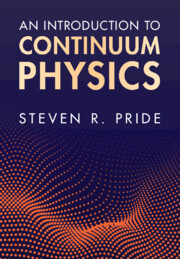Book contents
- Frontmatter
- Contents
- Preface
- Part I Continuum Physics
- 1 An Introduction to Tensor Calculus
- 2 Continuum Mechanics
- 3 Continuum Theory of Electromagnetism and Gravity
- 4 Elasticity and Elastodynamics
- 5 Fluid Dynamics
- 6 Equilibrium Thermodynamics
- 7 Nonequilibrium Diffusive Transport
- Part II Mathematical Methods
- References
- Index
7 - Nonequilibrium Diffusive Transport
from Part I - Continuum Physics
Published online by Cambridge University Press: 06 February 2025
- Frontmatter
- Contents
- Preface
- Part I Continuum Physics
- 1 An Introduction to Tensor Calculus
- 2 Continuum Mechanics
- 3 Continuum Theory of Electromagnetism and Gravity
- 4 Elasticity and Elastodynamics
- 5 Fluid Dynamics
- 6 Equilibrium Thermodynamics
- 7 Nonequilibrium Diffusive Transport
- Part II Mathematical Methods
- References
- Index
Summary
Nonequilibrium transport equations are derived for two types of diffusive systems: (1) viscous fluids made of a single molecular species that support thermal flux and (2) two-component (solute and solvent) miscible fluids that support solute flux and thermal flux. The general statement of energy conservation for any viscous fluid is derived and used to obtain the statement of entropy conservation for each system type. This identifies the irreversible entropy production of each system, which in turn produces linear transport laws relating the nonequilibrium diffusive flux to the gradients in the intensive parameters. The matrix of transport coefficients in the transport laws is proven to be symmetric (Onsager symmetry) using the continuum governing equations and requires the direction of flow to be reversed to obtain symmetry. Capillary physics is treated using Cahn–Hilliard theory that resolves the gradients in concentration across transition layers separating two immiscible, or partially miscible, fluid. The rules of contact-line movement (imbibition and drainage) in conduits are derived from a more macroscopic perspective where the transition layers are modeled as sharp interfaces.
Keywords
- Type
- Chapter
- Information
- An Introduction to Continuum Physics , pp. 393 - 456Publisher: Cambridge University PressPrint publication year: 2025

